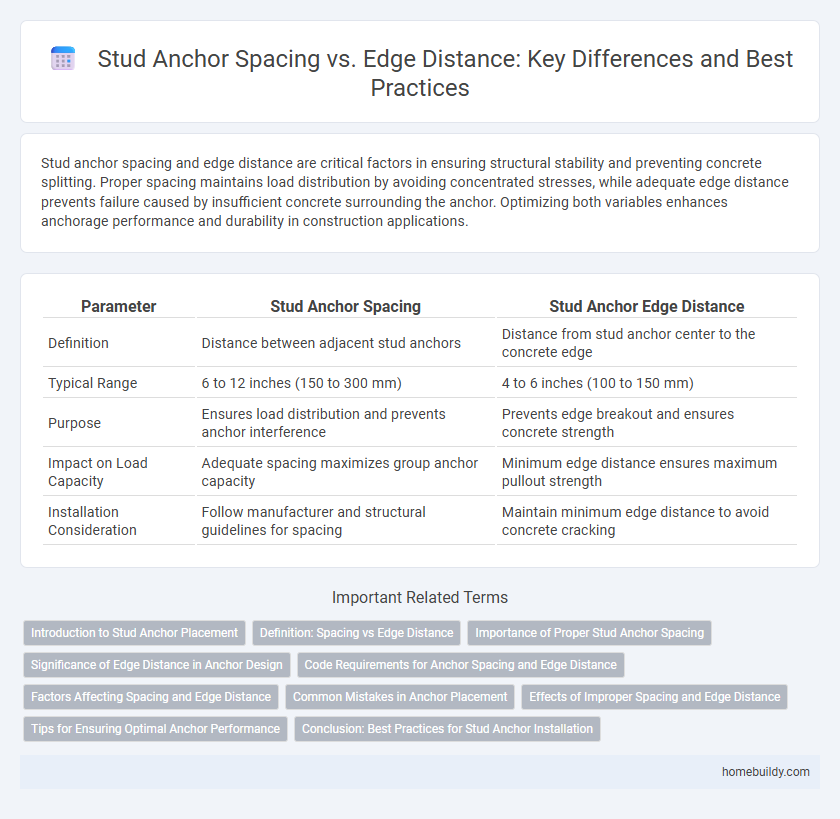Stud anchor spacing and edge distance are critical factors in ensuring structural stability and preventing concrete splitting. Proper spacing maintains load distribution by avoiding concentrated stresses, while adequate edge distance prevents failure caused by insufficient concrete surrounding the anchor. Optimizing both variables enhances anchorage performance and durability in construction applications.
Table of Comparison
| Parameter | Stud Anchor Spacing | Stud Anchor Edge Distance |
|---|---|---|
| Definition | Distance between adjacent stud anchors | Distance from stud anchor center to the concrete edge |
| Typical Range | 6 to 12 inches (150 to 300 mm) | 4 to 6 inches (100 to 150 mm) |
| Purpose | Ensures load distribution and prevents anchor interference | Prevents edge breakout and ensures concrete strength |
| Impact on Load Capacity | Adequate spacing maximizes group anchor capacity | Minimum edge distance ensures maximum pullout strength |
| Installation Consideration | Follow manufacturer and structural guidelines for spacing | Maintain minimum edge distance to avoid concrete cracking |
Introduction to Stud Anchor Placement
Proper stud anchor spacing and edge distance are critical to ensure structural integrity and prevent concrete cracking or anchor failure. Minimum spacing between stud anchors typically follows guidelines such as 4 times the anchor diameter to balance load distribution and avoid inter-anchor stress zones. Edge distance recommendations are often set at least 5 to 7 times the anchor diameter, optimizing load transfer while minimizing the risk of concrete breakout or splitting.
Definition: Spacing vs Edge Distance
Stud anchor spacing refers to the minimum horizontal distance between two adjacent stud anchors, ensuring load distribution without interference. Edge distance defines the minimum distance from a stud anchor to the edge of the concrete or base material to prevent cracking and ensure anchor integrity. Proper adherence to both spacing and edge distance is critical for structural performance and durability.
Importance of Proper Stud Anchor Spacing
Proper stud anchor spacing is critical to ensure structural integrity and load distribution in construction projects. Maintaining adequate edge distance prevents concrete cracking and enhances the anchor's pull-out strength, aligning with industry standards like ACI 318. Incorrect spacing or insufficient edge distance compromises anchorage performance, leading to potential safety hazards and costly repairs.
Significance of Edge Distance in Anchor Design
Edge distance in stud anchor design directly influences load-bearing capacity and installation integrity, as insufficient edge distance can lead to concrete breakout and anchor failure. Proper spacing ensures that anchors distribute stresses evenly, reducing the risk of localized cracking and enhancing structural durability. Adhering to manufacturer recommendations and engineering standards for minimum edge distance is critical for optimizing anchor performance and safety in concrete substrates.
Code Requirements for Anchor Spacing and Edge Distance
Code requirements for stud anchor spacing mandate a minimum distance of at least 4 times the anchor diameter to prevent concrete splitting and ensure load distribution. Edge distance must meet or exceed 1.5 times the anchor diameter to maintain structural integrity and avoid edge breakout under tension loads. Adherence to these spacing and edge distance standards per ACI and ICC codes optimizes the performance and safety of stud anchor installations.
Factors Affecting Spacing and Edge Distance
Stud anchor spacing and edge distance are critical design parameters influencing load distribution and structural integrity in concrete applications. Factors affecting these parameters include the anchor diameter, embedment depth, concrete strength, and the expected tensile or shear loads. Proper spacing ensures load transfer without concrete breakout, while adequate edge distance prevents premature cracking or splitting of the substrate.
Common Mistakes in Anchor Placement
Common mistakes in stud anchor placement often involve inadequate spacing and insufficient edge distance, which compromise load distribution and structural integrity. Insufficient spacing between anchors can lead to anchorage failure due to stress concentration and reduced frictional resistance. Incorrect edge distance increases the risk of concrete breakout or edge splitting, undermining the overall anchoring performance.
Effects of Improper Spacing and Edge Distance
Improper spacing and edge distance of stud anchors significantly reduce load capacity and increase the risk of concrete splitting or anchor failure. Insufficient edge distance can cause stress concentration, leading to concrete breakout and compromised structural integrity. Maintaining recommended spacing and edge distances is critical to ensure optimal load transfer and durability of stud anchor connections.
Tips for Ensuring Optimal Anchor Performance
Maintain minimum stud anchor spacing of at least 4 times the anchor diameter to prevent concrete cracking and ensure load distribution. Position stud anchors with a minimum edge distance of 6 times the anchor diameter to avoid edge failure and maximize pull-out resistance. Use high-strength materials and proper installation torque to enhance overall anchor performance and durability.
Conclusion: Best Practices for Stud Anchor Installation
Maintaining optimal stud anchor spacing and edge distance is critical for ensuring structural integrity and load distribution. Industry standards recommend a minimum edge distance of at least 4 times the anchor diameter and spacing of 6 times the diameter to prevent concrete breakout and ensure maximum load capacity. Proper adherence to these guidelines enhances durability and safety in stud anchor installations across various construction applications.
Stud anchor spacing vs edge distance Infographic

 homebuildy.com
homebuildy.com